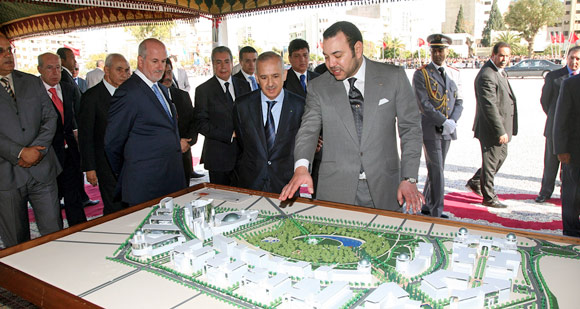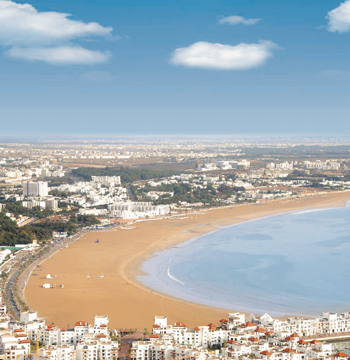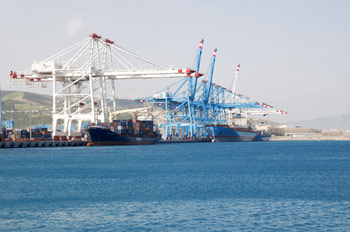Morocco Plan: Tourist, Trade & Economic Plan in Morocco
Morocco Top Stories
Morocco Plan: Tourist, Trade & Economic Plan in Morocco
Although beginning as one of the poorest Arab nations, lacking oil or major natural resources, and having an illiteracy rate of 87% upon achieving independence from the French Protectorate in 1956, Morocco has engaged in a massive national effort of education and economic development.

Morocco Plan: Tourist, Trade & Economic Plan in Morocco
> Political Reform
> Tourism: Concentrating on Comparative Advantage
> Trade Hub
> Industry
> Investments to Morocco
> Government by Agreement
Ever since the first stirrings of revolution began to ripple through the MENA (Middle East/North Africa) region on January 4th 2010, with the death by self-immolation of a Tunisian fruit vendor, uncertainty has gripped the Arab world. By January 18, 2010, the long-time president/dictator of Tunisia fled his country in the face of mass protests. Eleven days later Egypt erupted into demonstrations that led to the resignation of Hosni Mubarak on February 11th.
By March, Libya was in a state of civil war. In these months, major unrest threatened the stability of many other Arab states such as Bahrain, Yemen, Jordan, Syria.
The media presented the world with pictures of foreign nationals huddled at airports trying to escape; banks were closed in many countries; travel bans imposed; major investment projects were put on hold or cancelled; and millions of tourists cancelled airline and resort reservations to MENA region countries. Tour operators reported a vast diversion of business from MENA region destinations to other parts of the world.
Throughout this period, one narrative story-line has dominated the media: which domino will be the next to fall as unrest and revolution sweep the region? As one country after another erupted the story-line seemed to be confirmed: all of the MENA region was a powder keg.
But along with that story-line, another story-line has struggled to emerge; namely, that one country was different; that there was an exception, that there was one place in the MENA region safe for tourists and investors; where the government already reflected the will of the people.
Of all the Arab countries of North Africa and the Middle East, Morocco is the one least likely to suffer societal disruption or governmental change as a result of the democratic revolution—often called the Jasmine revolution—that has been sweeping the Arab world since January 2011.
The reasons for this are simple: Morocco has been engaging in democratic reforms and strenuous economic development programs designed to benefit the entire population for more than a decade. As a result, Morocco is poised on almost every factor to not only move to a position of leadership in the Arab world, but to benefit from increased investment and economic activity.
Although beginning as one of the poorest Arab nations, lacking oil or major natural resources, and having an illiteracy rate of 87% upon achieving independence from the French Protectorate in 1956, Morocco has engaged in a massive national effort of education and economic development.
Although beginning as one of the poorest Arab nations, lacking oil or major natural resources, and having an illiteracy rate of 87% upon achieving independence from the French Protectorate in 1956, Morocco has engaged in a massive national effort of democratization, human rights reform, education and economic development ever since the advent of new, young king who came to the throne in 1999.
By the 1990s, with the end of the Cold War and the advent of globalization, it was determined that the time was ripe for Morocco enter into the world economy as a major tourist destination, hub of trade, and have for profitable foreign investment. Constitutional changes were made to encourage increased democratic participation through political parties. Most particularly, however, the nation’s economic assets were surveyed with new eyes to see how they could be maximized for economic development.
Most particularly, however, the nation’s economic assets were surveyed with new eyes to see how they could be maximized for economic development. Thus, upon the death of King Hassan II, who had ruled from 1961 to 1999, the way was prepared for the new king, Mohammed VI, to project a plan for Morocco to enter the 21st century taking advantage of all the new economic opportunities available.
King Mohammed VI moved rapidly on almost every front to reorganize the nation for economic growth and to liberate its inherent entrepreneurial skills. This involved five policy directions:
Political Reform
Mohammed VI ended the arbitrary police and security policies left over from the Cold War by publicly removing the dreaded security chief most responsible for abuses.
He also pardoned prisoners, allowed exiles to return, and welcomed critics into the legislature and government. But his most impressive acts were setting up successive commissions to publicly review abuses that occurred under his father’s reign, and paying damages or reparations for those who had been wrongly imprisoned or abused.
These actions clearly cemented the image of Mohammed VI as a democratic reformer.
Tourism: Concentrating on Comparative Advantage
After taking inventory of its assets, Morocco determined that its greatest advantage lay in taking advantage of its nearly 2,000 km. of California-like beaches and its romantic cities (Marrakech, Casablanca, Tangier, Fes, etc.) to maximize the tourist trade.
In 2001 King Mohammed VI set forth a plan to mobilize the entire resources of the nation to expand its tourist accommodations, transportation networks, and tourist facilities and events. It also encompassed planning, securing investors for, and building six new resort cities along the coast.
This entire plan was called “Vision 2010” and it involved a massive reorganization of government priorities, and mobilization of the skills of the people to prepare for the welcoming of more than twice the number of tourists by 2010.
Trade Hub
After its sunny beaches, Morocco determined that its next greatest advantage lay in its geographical location on the northwest corner of Africa facing onto both the Mediterranean and Atlantic—just 14 km. from Spain. This would be an ideal hub for trade between the Europe and both Americas as well as the rest of Africa and the Middle East.
In order to enter the global economy, Morocco set out to establish trade relations with as many countries as possible and on the best terms possible. Prior to 2000, Morocco’s prime trading partners were France, Spain, and the U.K. In 2004, Morocco signed the first Free Trade Agreement (FTA) of any Arab nation with the US. 
It also sought trade partnership with the EU, which Morocco obtained in 2008 by being granted “advanced status,”which entails partnership with all the countries of the EU in all but EU membership.
Trade agreements have also been concluded with most of the Arab states, and numerous other countries in South America and throughout the world, including China, Malaysia, Indonesia, and India. Major efforts are now in process to complete trade agreements with the remaining states on the African continent. Morocco now possesses the most extensive set of trade agreements of any country in North Africa.
Industry
With trade agreements in place, Morocco could next take advantage of lower labor rates to attract investment in industry, off-shoring (out-sourcing), and new global technologies. Prior to 2000, Morocco possessed little industry beyond textiles and handicrafts.
But with free trade areas and huge logistics hubs, such as were planned, for example, at Tangier, industry has been attracted to take advantage of Morocco’s comparative labor rates, sunny climate, and tax advantages. Today, Morocco has a thriving automobile parts industry, and attracting many new industries to its logistics hubs and industrial parks.
Investment
Investors are attracted to plans showing an overall vision and concrete details. The King’s vision called on every department of government to envisage and start making plans for investors to invest in. The six new resort cities of Plan Azur were only dreams in 2001.
But over the next eight years the necessary ecological studies, and architectural plans made, streets laid out, and utilities planned until by 2009 the first bids could be let.
Now two of those communities are being built, and bid offerings are ready for the others. Tangier slowly developed its plans as a major logistical hub, and most of its new and extensive facilities are now being built.
Moroccans are encouraged to imagine everything from new restaurants or cab services to serve tourists, and governmental regional investment centers helped them get organized, find investors, and meet the needs of the market.
Tens of thousands of new businesses have been created by small Morrocan entrepreneurs, and foreign investors have poured hundred of millions of dollars into new industries and resorts in Morocco.
Government by Agreement
All of these were presented as parts of the King’s “vision” in 2001 and ramped up in subsequent years. But it was not just words, laws, or decrees. With every “vision” articulated by the king was a concrete plan of steps to be taken to achieve the goals—and this plan was encompassed not in laws or commands, but in signed agreements that the king prepared for each actor to sign in ink.
Thus immediately after his public speech describing “Vision 2010,” scores of bankers, regional governors,  tourist operators, airport planners, etc. were asked to “sign on” both to the goals and the steps that they were committed to take to reach them. Thus the king’s method taught a valuable lesson: that they, the signers, were in charge, and that real democracy worked by every key actor taking responsibility for making their part of the plan a success.
tourist operators, airport planners, etc. were asked to “sign on” both to the goals and the steps that they were committed to take to reach them. Thus the king’s method taught a valuable lesson: that they, the signers, were in charge, and that real democracy worked by every key actor taking responsibility for making their part of the plan a success.
2010 has now already come and gone, and we are now in a position to evaluate how well its goals have been reached.
As we shall see, they have been reached to a degree that probably no outsider would have dreamed possible in 2001. By the end of 2010, tourist arrivals stood at 9.4 mil.—5 million more than the 4.4 mil of 2001, and had achieved 94% of the King’s goal—a truly remarkable achievement.
But the King’s vision encompassed much more than the goal of increasing the number of tourists. It involved organizing the whole country into searching for opportunities in the global marketplace; preparing for them, applying for them, and securing them for development.
A glance at headlines in the Global Arab News Network over the past three months shows the success of the Moroccan model—and the kind of exception that Morocco is proving to be:
Morocco, US to boost renewable energy cooperation
Direct flights between Saint Petersburg and Agadir to be launched
Morocco Joins OECD Development Centre
Qatar, Morocco boosting energy cooperation
IOPCF: Morocco – a key role within international maritime community
Morocco, US trade exchange exceeds $ 2.5 billion
Morocco, China Sign MoU to Enhance Investment Cooperation
Morocco reform attracts foreign investment
Morocco, France sign agreement to enhance industrial promotion
Morocco Attracts More Businesses and Investment from Spain
International Fund for Agricultural Development grants Morocco 22.5 mil. USD
World Bank grants Morocco $ 342 million for development projects
Morocco: Textiles Gearing up to Meet Demand
Washington Post: Morocco trendsetter in the region
Morocco expects economy to grow by 4%
Morocco and EU sign agreement to develop remote regions
Morocco: World Commends King’s Reforms
Morocco Promoting Dynamic Tourism
Morocco invests $10 million in oil exploration
Morocco, UK Strengthening Political Relations
Morocco, Japan Bank for International Cooperation promoting economic relation
Spain: Jobelsa car components investing in Morocco
Morocco urges honouring commitments to Africa’s development
Morocco, Turkey strengthening energy cooperation
Morocco Showcases Investments Opportunities to French Car-makers
Morocco, Vietnam strengthening economic cooperation
Morocco, Turkey identifying mechanisms to promote trade and investments
Rabat Hosts Morocco Turkey Economic Joint Committee
Morocco, Turkey boosting economic cooperation
France-based CCA International Creating 300 New Jobs in Morocco
As this sample of headlines indicates, those governments and investors familiar with Morocco as an exception to the unrest in the Middle East, are moving to increase cooperation and to take advantage of the opportunities offered by the one center of stability in the region.
The slogan of the Moroccan Agency for Tourism is: “Come and earn money with us,” and its philosophy is “We want to make partnerships ‘win-win.'”
Today, as Morocco emerges as one of the few safe and stable tourist and investment destinations in North Africa, this country is poised to become the biggest economic success story of North Africa and the Arab world.
Similarly, as investors look around for stable environments and well-planned opportunities, the Moroccan economy begins to look like an the richest oasis in the desert.